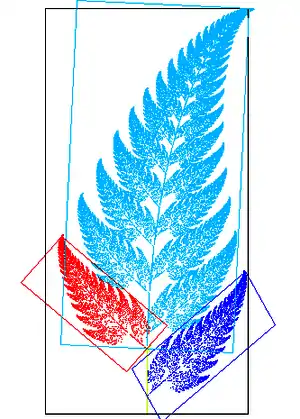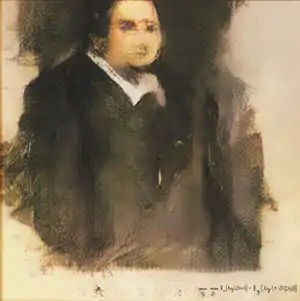Barnsley fern
The Barnsley fern is a fractal named after the British mathematician Michael Barnsley who first described it in his book Fractals Everywhere.[1] He made it to resemble the black spleenwort, Asplenium adiantum-nigrum.
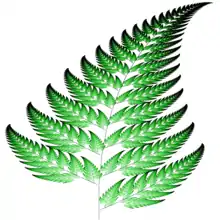
History
The fern is one of the basic examples of self-similar sets, i.e. it is a mathematically generated pattern that can be reproducible at any magnification or reduction. Like the Sierpinski triangle, the Barnsley fern shows how graphically beautiful structures can be built from repetitive uses of mathematical formulas with computers. Barnsley's 1988 book Fractals Everywhere is based on the course which he taught for undergraduate and graduate students in the School of Mathematics, Georgia Institute of Technology, called Fractal Geometry. After publishing the book, a second course was developed, called Fractal Measure Theory.[1] Barnsley's work has been a source of inspiration to graphic artists attempting to imitate nature with mathematical models.
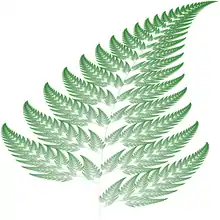
The fern code developed by Barnsley is an example of an iterated function system (IFS) to create a fractal. This follows from the collage theorem. He has used fractals to model a diverse range of phenomena in science and technology, but most specifically plant structures.
IFSs provide models for certain plants, leaves, and ferns, by virtue of the self-similarity which often occurs in branching structures in nature. But nature also exhibits randomness and variation from one level to the next; no two ferns are exactly alike, and the branching fronds become leaves at a smaller scale. V-variable fractals allow for such randomness and variability across scales, while at the same time admitting a continuous dependence on parameters which facilitates geometrical modelling. These factors allow us to make the hybrid biological models... ...we speculate that when a V -variable geometrical fractal model is found that has a good match to the geometry of a given plant, then there is a specific relationship between these code trees and the information stored in the genes of the plant.
—Michael Barnsley et al.[2]
Construction
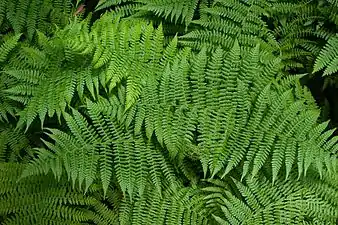
Barnsley's fern uses four affine transformations. The formula for one transformation is the following:
Barnsley shows the IFS code for his Black Spleenwort fern fractal as a matrix of values shown in a table.[3] In the table, the columns "a" through "f" are the coefficients of the equation, and "p" represents the probability factor.
| w | a | b | c | d | e | f | p | Portion generated |
|---|---|---|---|---|---|---|---|---|
| ƒ1 | 0 | 0 | 0 | 0.16 | 0 | 0 | 0.01 | Stem |
| ƒ2 | 0.85 | 0.04 | −0.04 | 0.85 | 0 | 1.60 | 0.85 | Successively smaller leaflets |
| ƒ3 | 0.20 | −0.26 | 0.23 | 0.22 | 0 | 1.60 | 0.07 | Largest left-hand leaflet |
| ƒ4 | −0.15 | 0.28 | 0.26 | 0.24 | 0 | 0.44 | 0.07 | Largest right-hand leaflet |
These correspond to the following transformations:
Computer generation

Though Barnsley's fern could in theory be plotted by hand with a pen and graph paper, the number of iterations necessary runs into the tens of thousands, which makes use of a computer practically mandatory. Many different computer models of Barnsley's fern are popular with contemporary mathematicians. As long as the math is programmed correctly using Barnsley's matrix of constants, the same fern shape will be produced.
The first point drawn is at the origin (x0 = 0, y0 = 0) and then the new points are iteratively computed by randomly applying one of the following four coordinate transformations:[4][5]
ƒ1
- xn + 1 = 0
- yn + 1 = 0.16 yn.
This coordinate transformation is chosen 1% of the time and just maps any point to a point in the first line segment at the base of the stem. This part of the figure is the first to be completed during the course of iterations.
ƒ2
- xn + 1 = 0.85 xn + 0.04 yn
- yn + 1 = −0.04 xn + 0.85 yn + 1.6.
This coordinate transformation is chosen 85% of the time and maps any point inside the leaflet represented by the red triangle to a point inside the opposite, smaller leaflet represented by the blue triangle in the figure.
ƒ3
- xn + 1 = 0.2 xn − 0.26 yn
- yn + 1 = 0.23 xn + 0.22 yn + 1.6.
This coordinate transformation is chosen 7% of the time and maps any point inside the leaflet (or pinna) represented by the blue triangle to a point inside the alternating corresponding triangle across the stem (it flips it).
ƒ4
- xn + 1 = −0.15 xn + 0.28 yn
- yn + 1 = 0.26 xn + 0.24 yn + 0.44.
This coordinate transformation is chosen 7% of the time and maps any point inside the leaflet (or pinna) represented by the blue triangle to a point inside the alternating corresponding triangle across the stem (without flipping it).
The first coordinate transformation draws the stem. The second generates successive copies of the stem and bottom fronds to make the complete fern. The third draws the bottom frond on the left. The fourth draws the bottom frond on the right. The recursive nature of the IFS guarantees that the whole is a larger replica of each frond. Note that the complete fern is within the range −2.1820 < x < 2.6558 and 0 ≤ y < 9.9983.
Mutant varieties
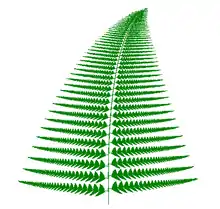
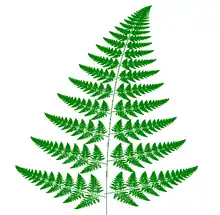
By playing with the coefficients, it is possible to create mutant fern varieties. In his paper on V-variable fractals, Barnsley calls this trait a superfractal.[2]
One experimenter has come up with a table of coefficients to produce another remarkably naturally looking fern however, resembling the Cyclosorus or Thelypteridaceae fern. These are:[6][7]
| w | a | b | c | d | e | f | p |
|---|---|---|---|---|---|---|---|
| ƒ1 | 0 | 0 | 0 | 0.25 | 0 | −0.4 | 0.02 |
| ƒ2 | 0.95 | 0.005 | −0.005 | 0.93 | −0.002 | 0.5 | 0.84 |
| ƒ3 | 0.035 | −0.2 | 0.16 | 0.04 | −0.09 | 0.02 | 0.07 |
| ƒ4 | −0.04 | 0.2 | 0.16 | 0.04 | 0.083 | 0.12 | 0.07 |
Syntax examples
You can use the below syntax to draw the fern yourself.
Python
import turtle
import random
pen = turtle.Turtle()
pen.speed(15)
pen.color("blue")
pen.penup()
x = 0
y = 0
for n in range(110000):
pen.goto(65 * x, 37 * y - 252) # 57 is to scale the fern and -275 is to start the drawing from the bottom.
pen.pendown()
pen.dot()
pen.penup()
r = random.random() # to get probability
r = r * 100
xn = x
yn = y
if r < 1: # elif ladder based on the probability
x = 0
y = 0.16 * yn
elif r < 86:
x = 0.85 * xn + 0.04 * yn
y = -0.04 * xn + 0.85 * yn + 1.6
elif r < 93:
x = 0.20 * xn - 0.26 * yn
y = 0.23 * xn + 0.22 * yn + 1.6
else:
x = -0.15 * xn + 0.28 * yn
y = 0.26 * xn + 0.24 * yn + 0.44
R
# Barnsley's Fern
# create function of the probability and the current point
fractal_fern2 <- function(x, p){
if (p <= 0.01) {
m <- matrix(c(0, 0, 0, .16), 2, 2)
f <- c(0, 0)
} else if (p <= 0.86) {
m <- matrix(c(.85, -.04, .04, .85), 2, 2)
f <- c(0, 1.6)
} else if (p <= 0.93) {
m <- matrix(c(.2, .23, -.26, .22), 2, 2)
f <- c(0, 1.6)
} else {
m <- matrix(c(-.15, .26, .28, .24), 2, 2)
f <- c(0, .44)
}
m %*% x + f
}
# how many reps determines how detailed the fern will be
reps <- 10000
# create a vector with probability values, and a matrix to store coordinates
p <- runif(reps)
# initialise a point at the origin
coords <- c(0, 0)
# compute Fractal Coordinates
m <- Reduce(fractal_fern2, p, accumulate = T, init = coords)
m <- t(do.call(cbind, m))
# Create plot
plot(m, type = "p", cex = 0.1, col = "darkgreen",
xlim = c(-3, 3), ylim = c(0, 10),
xlab = NA, ylab = NA, axes = FALSE)
Processing
/*
Barnsley Fern for Processing 3.4
*/
// declaring variables x and y
float x, y;
// creating canvas
void setup() {
size(600, 600);
background(255);
}
/* setting stroke, mapping canvas and then
plotting the points */
void drawPoint() {
stroke(34, 139, 34);
strokeWeight(1);
float px = map(x, -2.1820, 2.6558, 0, width);
float py = map(y, 0, 9.9983, height, 0);
point(px, py);
}
/* algorithm for calculating value of (n+1)th
term of x and y based on the transformation
matrices */
void nextPoint() {
float nextX, nextY;
float r = random(1);
if (r < 0.01) {
nextX = 0;
nextY = 0.16 * y;
} else if (r < 0.86) {
nextX = 0.85 * x + 0.04 * y;
nextY = -0.04 * x + 0.85 * y + 1.6;
} else if (r < 0.93) {
nextX = 0.20 * x - 0.26 * y;
nextY = 0.23 * x + 0.22 * y + 1.6;
} else {
nextX = -0.15 * x + 0.28 * y;
nextY = 0.26 * x + 0.24 * y + 0.44;
}
x = nextX;
y = nextY;
}
/* iterate the plotting and calculation
functions over a loop */
void draw() {
for (int i = 0; i < 100; i++) {
drawPoint();
nextPoint();
}
}
P5.JS
let x = 0;
let y = 0;
function setup() {
createCanvas(600, 600);
background(0);
}
//range −2.1820 < x < 2.6558 and 0 ≤ y < 9.9983.
function drawPoint() {
stroke(255);
strokeWeight(1);
let px = map(x, -2.1820, 2.6558, 0, width);
let py = map(y, 0, 9.9983, height, 0);
point(px, py);
}
function nextPoint() {
let nextX;
let nextY;
let r = random(1);
if (r < 0.01) {
//1
nextX = 0;
nextY = 0.16 * y;
} else if (r < 0.86) {
//2
nextX = 0.85 * x + 0.04 * y;
nextY = -0.04 * x + 0.85 * y + 1.60;
} else if (r < 0.93) {
//3
nextX = 0.20 * x + -0.26 * y;
nextY = 0.23 * x + 0.22 * y + 1.60;
} else {
//4
nextX = -0.15 * x + 0.28 * y;
nextY = 0.26 * x + 0.24 * y + 0.44;
}
x = nextX;
y = nextY;
}
function draw() {
for (let i = 0; i < 1000; i++) {
drawPoint();
nextPoint();
}
}
JavaScript (HTML5)
<canvas id="canvas" height="700" width="700">
</canvas>
<script>
let canvas;
let canvasContext;
let x = 0, y = 0;
window.onload = function () {
canvas = document.getElementById("canvas");
canvasContext = canvas.getContext('2d');
canvasContext.fillStyle = "black";
canvasContext.fillRect(0, 0, canvas.width, canvas.height);
setInterval(() => {
// Update 20 times every frame
for (let i = 0; i < 20; i++)
update();
}, 1000/250); // 250 frames per second
};
function update() {
let nextX, nextY;
let r = Math.random();
if (r < 0.01) {
nextX = 0;
nextY = 0.16 * y;
} else if (r < 0.86) {
nextX = 0.85 * x + 0.04 * y;
nextY = -0.04 * x + 0.85 * y + 1.6;
} else if (r < 0.93) {
nextX = 0.20 * x - 0.26 * y;
nextY = 0.23 * x + 0.22 * y + 1.6;
} else {
nextX = -0.15 * x + 0.28 * y;
nextY = 0.26 * x + 0.24 * y + 0.44;
}
// Scaling and positioning
let plotX = canvas.width * (x + 3) / 6;
let plotY = canvas.height - canvas.height * ((y + 2) / 14);
drawFilledCircle(plotX, plotY, 1, "green");
x = nextX;
y = nextY;
}
const drawFilledCircle = (centerX, centerY, radius, color) => {
canvasContext.beginPath();
canvasContext.fillStyle = color;
canvasContext.arc(centerX, centerY, radius, 0, 2 * Math.PI, true);
canvasContext.fill();
};
</script>
QBasic
SCREEN 12
WINDOW (-5, 0)-(5, 10)
RANDOMIZE TIMER
COLOR 10
DO
SELECT CASE RND
CASE IS < .01
nextX = 0
nextY = .16 * y
CASE .01 TO .08
nextX = .2 * x - .26 * y
nextY = .23 * x + .22 * y + 1.6
CASE .08 TO .15
nextX = -.15 * x + .28 * y
nextY = .26 * x + .24 * y + .44
CASE ELSE
nextX = .85 * x + .04 * y
nextY = -.04 * x + .85 * y + 1.6
END SELECT
x = nextX
y = nextY
PSET (x, y)
LOOP UNTIL INKEY$ = CHR$(27)
VBA (CorelDraw)
Sub Barnsley()
Dim iEnd As Long
Dim i As Long
Dim x As Double
Dim y As Double
Dim nextX As Double
Dim nextY As Double
Dim sShapeArray() As Shape
Dim dSize As Double
Dim sColor As String
dSize = 0.01 ' Size of the dots
sColor = "0,0,100" ' RGB color of dots, value range 0 to 255
iEnd = 5000 ' Number of iterations
ReDim sShapeArray(iEnd)
' In Corel, each object drawn requires a variable name of its own
Randomize ' Initialize the Rnd function
For i = 0 To iEnd ' Iterate ...
Select Case Rnd
Case Is < 0.01
' f1 = Draw stem
nextX = 0
nextY = 0.16 * y
Case 0.01 To 0.08
' f3
nextX = 0.2 * x - 0.26 * y
nextY = 0.23 * x + 0.22 * y + 1.6
Case 0.08 To 0.15
' f4
nextX = -0.15 * x + 0.28 * y
nextY = 0.26 * x + 0.24 * y + 0.44
Case Else
' f2
nextX = 0.85 * x + 0.04 * y
nextY = -0.04 * x + 0.85 * y + 1.6
End Select
x = nextX
y = nextY
Set sShapeArray(i) = ActiveLayer.CreateEllipse2(x + 2.5, y + 0.5, dSize)
sShapeArray(i).Style.StringAssign "{""fill"":{""primaryColor"":""RGB255,USER," & sColor & ",100,00000000-0000-0000-0000-000000000000"",""secondaryColor"":""RGB255,USER,255,255,255,100,00000000-0000-0000-0000-000000000000"",""type"":""1"",""fillName"":null},""outline"":{""width"":""0"",""color"":""RGB255,USER,0,0,0,100,00000000-0000-0000-0000-000000000000""},""transparency"":{}}"
DoEvents
Next
End Sub
Amola
addpackage("Forms.dll")
set("x", 0)
set("y", 0)
set("width", 600)
set("height", 600)
method setup()
createCanvas(width, height)
rect(0, 0, 600, 600, color(0, 0, 0))
end
method drawPoint()
set("curX", div(mult(width, add(x, 3)), 6))
set("curY", sub(height, mult(height, div(add(y, 2), 14))))
set("size", 1)
//log(curX)
//log(curY)
rect(round(curX - size / 2), round(curY - size / 2), round(curX + size / 2), round(curY + size / 2), color(34, 139, 34))
end
method nextPoint()
set("nextX", 0)
set("nextY", 0)
set("random", random(0, 100))
if(random < 1)
set("nextX", 0)
set("nextY", 0.16 * y)
end
else
if(random < 86)
set("nextX", 0.85 * x + 0.04 * y)
set("nextY", -0.04 * x + 0.85 * y + 1.6)
end
else
if(random < 93)
set("nextX", 0.2 * x - 0.26 * y)
set("nextY", 0.23 * x + 0.22 * y + 1.6)
end
else
set("nextX", -0.15 * x + 0.28 * y)
set("nextY", 0.26 * x + 0.24 * y + 0.44)
end
end
end
set("x", nextX)
set("y", nextY)
end
setup()
while(true)
drawPoint()
nextPoint()
end
TSQL
/* results table */
declare @fern table (Fun int, X float, Y float, Seq int identity(1,1) primary key, DateAdded datetime default getdate())
declare @i int = 1 /* iterations */
declare @fun int /* random function */
declare @x float = 0 /* initialise X = 0 */
declare @y float = 0 /* initialise Y = 0 */
declare @rand float
insert into @fern (Fun, X, Y) values (0,0,0) /* set starting point */
while @i < 5000 /* how many points? */
begin
set @rand = rand()
select @Fun = case /* get random function to use -- @fun = f1 = 1%, f2 = 85%, f3 = 7%, f4 = 7% */
when @rand <= 0.01 then 1
when @rand <= 0.86 then 2
when @rand <= 0.93 then 3
when @rand <= 1 then 4
end
select top 1 @X = X, @Y = Y from @fern order by Seq desc /* get previous point */
insert into @fern(Fun, X, Y) /* transform using four different function expressions */
select @fun,
case @fun
when 1 then 0
when 2 then 0.85*@x+0.04*@y
when 3 then 0.2*@x-0.26*@y
when 4 then -0.15*@x + 0.28*@y
end X,
case @fun
when 1 then 0.16*@y
when 2 then -0.04*@x + 0.85*@y + 1.6
when 3 then 0.23*@x + 0.22*@y + 1.6
when 4 then 0.26*@x + 0.24*@y + 0.44
end Y
set @i=@i+1
end
select top 5000 *,geography::Point(Y, X, 4326) from @fern
order by newid()
MATLAB
AI = [0 0 ; 0 0.16];
AII = [ 0.85 0.04 ; -0.04 0.85 ] ;
AIII = [ 0.2 -0.26 ; 0.23 0.22 ] ;
AIV = [-0.15 0.28 ; 0.26 0.24 ];
BI = [ 0 ; 0];
BII = [ 0 ; 1.6];
BIII = [ 0 ; 1.6];
BIV = [0 ; 0.44];
N = 100000;
H = zeros(N,2);
x = 0;
y = 0;
T = [x;y];
for i=2 : N
p = rand;
if p < 0.01
%disp('Scheme 1')
S1 = AI*T + BI;
x = S1(1);
y = S1(2);
elseif p < 0.85
%disp('Scheme 2')
S2 = AII*T + BII;
x = S2(1);
y = S2(2);
elseif p < 0.93
%disp('Scheme 3')
S3 = AIII*T + BII;
x = S3(1);
y = S3(2);
else
%disp('Scheme 4')
S4 = AIV*T + BIV;
x = S4(1);
y = S4(2);
end
%%Update T
T = [x;y];
H(i,1) = x;
H(i,2) = y;
end
X = H(:,1);
Y = H(:,2);
plot(X,Y,'.', 'Color', [79, 121, 66]/256, 'markersize', 0.1)
References
- Fractals Everywhere, Boston, MA: Academic Press, 1993, ISBN 0-12-079062-9
- Michael Barnsley, et al.,""V-variable fractals and superfractals"" (PDF). (2.22 MB)
- Fractals Everywhere, table III.3, IFS code for a fern.
- Barnsley, Michael (2000). Fractals everywhere. Morgan Kaufmann. p. 86. ISBN 0-12-079069-6. Retrieved 2010-01-07.
- Weisstein, Eric. "Barnsley's Fern". Retrieved 2010-01-07.
- Other fern varieties with supplied coefficients, retrieved 2010-1-7
- A Barnsley fern generator

